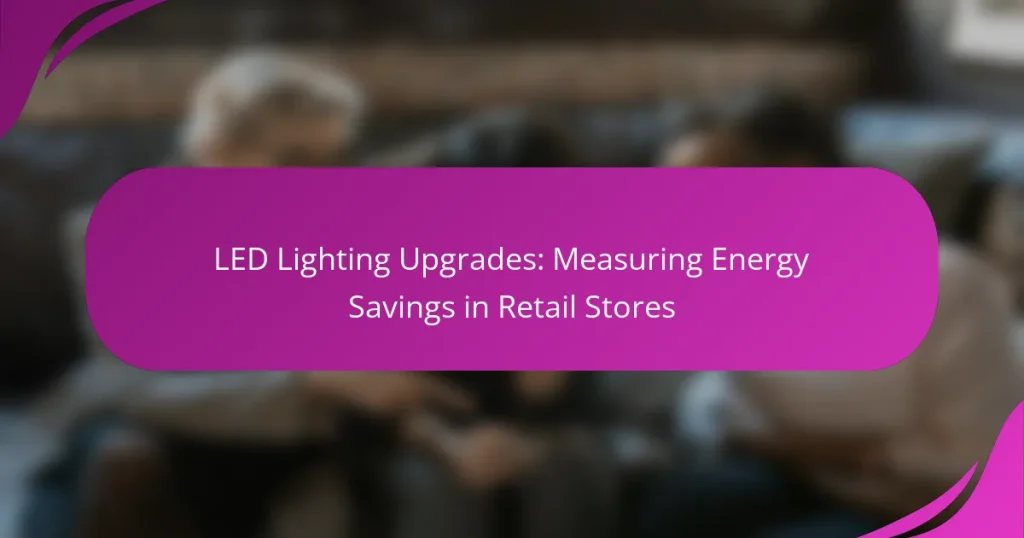Upgrading to LED lighting in retail stores can lead to substantial energy savings by consuming less electricity than traditional lighting solutions. This not only helps lower monthly utility expenses but also supports a more sustainable business approach. To effectively measure these energy savings, it is essential to compare energy consumption before and after the installation, utilizing usage data and local electricity rates for accurate calculations.
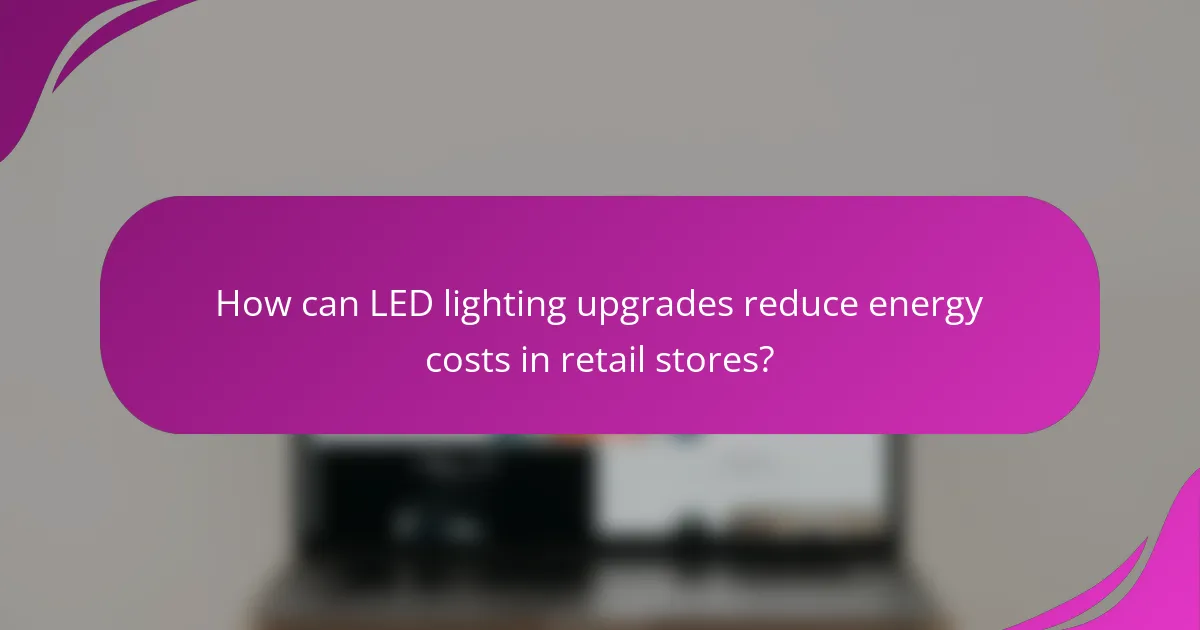
How can LED lighting upgrades reduce energy costs in retail stores?
LED lighting upgrades can significantly lower energy costs in retail stores by using less electricity compared to traditional lighting options. This reduction in energy consumption not only decreases monthly utility bills but also contributes to a more sustainable business model.
Up to 75% energy savings
Switching to LED lighting can lead to energy savings of up to 75% compared to incandescent or fluorescent bulbs. This efficiency comes from LEDs’ ability to convert a higher percentage of energy into light rather than heat, making them a superior choice for retail environments.
For example, if a retail store currently spends around $1,000 monthly on lighting, switching to LED could potentially reduce that cost to around $250. This substantial savings can significantly impact overall operational expenses.
Lower maintenance costs
LED lights have a longer lifespan than traditional bulbs, often lasting 15,000 to 50,000 hours. This longevity means fewer replacements are needed, which translates to lower maintenance costs for retail stores. Less frequent bulb changes reduce labor costs and minimize disruption to store operations.
Additionally, many LED fixtures are designed to be more durable and resistant to breakage, further decreasing maintenance needs. Retailers can expect to save both time and money by investing in LED technology, allowing them to focus more on customer service rather than lighting upkeep.

What are the best LED lighting options for retail environments?
The best LED lighting options for retail environments focus on energy efficiency, customization, and enhancing the shopping experience. Selecting the right products can significantly reduce energy costs while creating an inviting atmosphere for customers.
Philips Hue for customizable lighting
Philips Hue offers a range of smart LED bulbs that allow retailers to customize lighting based on the time of day or specific promotions. This flexibility can enhance the shopping experience by creating different moods or highlighting certain products.
Retailers can control Philips Hue lights via a smartphone app, enabling easy adjustments to brightness and color temperature. This adaptability can lead to increased customer engagement and potentially higher sales.
GE LED for energy efficiency
GE LED lights are designed for energy efficiency, providing significant savings on electricity bills compared to traditional lighting options. These bulbs typically use up to 80% less energy, making them a cost-effective choice for retail stores looking to reduce operational expenses.
In addition to energy savings, GE LEDs have a long lifespan, often lasting over 15,000 hours. Retailers can benefit from lower maintenance costs and reduced frequency of replacements, allowing them to focus on their core business activities.

How to measure energy savings from LED upgrades?
Measuring energy savings from LED upgrades involves comparing energy consumption before and after the installation. This process typically requires tracking usage data and calculating cost reductions based on local electricity rates.
Using energy monitoring tools
Energy monitoring tools are essential for accurately measuring the impact of LED upgrades. These devices can track real-time energy consumption, allowing retailers to see how much energy is saved compared to traditional lighting systems.
Consider using smart meters or energy management software that provides detailed analytics. Many of these tools can integrate with existing systems, offering insights into usage patterns and peak consumption times.
Calculating return on investment (ROI)
Calculating ROI for LED upgrades involves assessing both the initial costs and the ongoing savings. Start by determining the total investment, including purchase, installation, and maintenance costs, then compare this to the expected energy savings over time.
A simple formula to calculate ROI is: (Net Savings / Total Investment) x 100. For example, if a retail store invests $10,000 in LED lighting and saves $2,000 annually, the ROI would be 20%. This metric helps retailers understand the financial benefits of their upgrades.
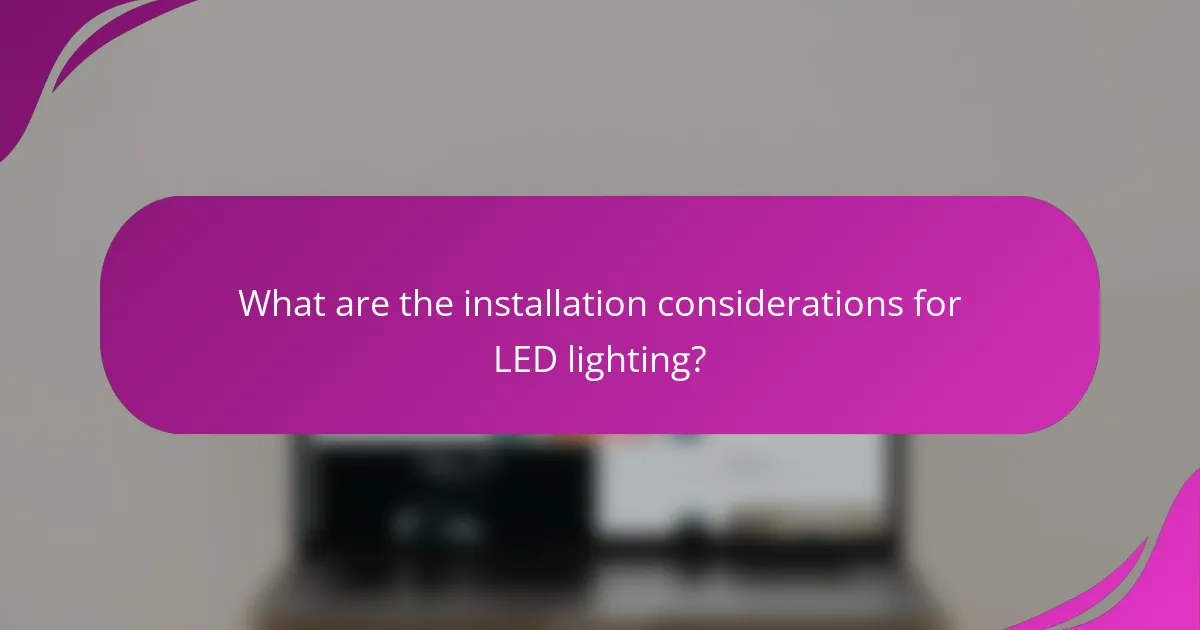
What are the installation considerations for LED lighting?
When upgrading to LED lighting in retail stores, key installation considerations include professional installation requirements and compatibility with existing fixtures. Proper planning ensures optimal performance and energy savings.
Professional installation requirements
Hiring a qualified electrician is essential for LED lighting installation to ensure safety and compliance with local electrical codes. Professionals can assess the existing electrical system and make necessary adjustments to accommodate the new lighting.
Additionally, they can help with the layout design to maximize light distribution and energy efficiency. This may involve calculating the appropriate wattage and lumens needed for different areas within the store.
Compatibility with existing fixtures
Before installing LED lights, check if the new bulbs are compatible with existing fixtures. Some LED products require specific types of fixtures or may not work with dimmer switches without additional components.
Consider retrofitting options if the current fixtures are not compatible. This can involve replacing or modifying fixtures to ensure they can support LED technology, which can lead to better energy savings and improved lighting quality.
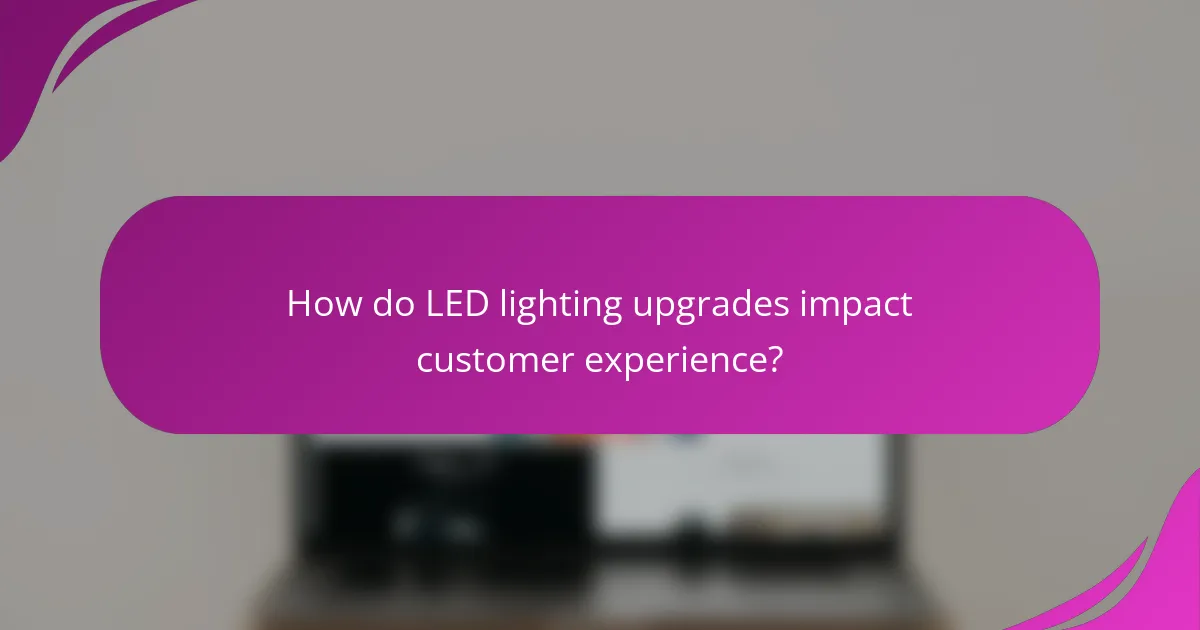
How do LED lighting upgrades impact customer experience?
LED lighting upgrades significantly enhance customer experience by improving visibility and creating a more inviting atmosphere. These upgrades not only attract customers but also influence their purchasing decisions through better product presentation.
Improved product visibility
LED lights provide brighter and more focused illumination, which enhances product visibility in retail stores. This clarity helps customers easily identify products, leading to increased interest and potential sales.
For example, using LED lights in display cases can highlight key items, making them stand out. Retailers should consider positioning LED fixtures strategically to minimize shadows and maximize light distribution across products.
Enhanced store ambiance
Upgrading to LED lighting can transform the overall ambiance of a retail space, making it feel more modern and appealing. The ability to adjust color temperatures allows retailers to create a warm, inviting environment or a cool, energetic space depending on their brand identity.
Consider using warmer LED tones in clothing stores to create a cozy feel, while cooler tones may be more suitable for electronics shops. Retailers should also be mindful of dimming options, which can further enhance the shopping experience during different times of the day.

What are the environmental benefits of LED lighting?
LED lighting offers significant environmental benefits, primarily through energy efficiency and reduced waste. By consuming less power and having a longer lifespan, LEDs contribute to lower greenhouse gas emissions and less frequent replacements.
Reduced carbon footprint
Switching to LED lighting can substantially lower a retail store’s carbon footprint. LEDs use up to 80% less energy than traditional incandescent bulbs, which means less electricity generation and, consequently, fewer carbon emissions. For example, a store that replaces 100 incandescent bulbs with LEDs could save several tons of CO2 emissions annually.
Additionally, many regions have energy efficiency programs that incentivize the adoption of LED technology, further enhancing these savings. Retailers should consider local utility rebates and tax credits when calculating the overall environmental impact of their lighting upgrades.
Less hazardous waste
LED lights generate significantly less hazardous waste compared to traditional lighting options like fluorescent bulbs, which contain mercury. This reduction in hazardous materials means that fewer toxic substances end up in landfills, contributing to a cleaner environment.
Moreover, the longer lifespan of LEDs—often lasting up to 25,000 hours—means fewer replacements are necessary, which translates to less waste generated over time. Retailers should implement proper disposal methods for any remaining non-LED lights to ensure compliance with local regulations regarding hazardous waste management.
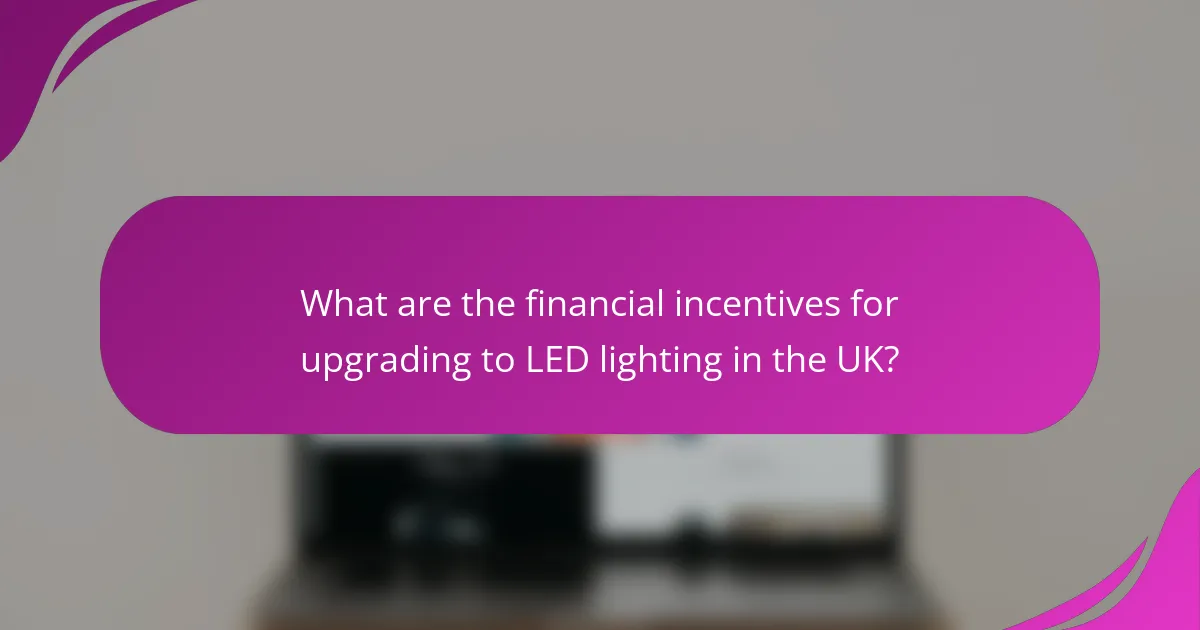
What are the financial incentives for upgrading to LED lighting in the UK?
Upgrading to LED lighting in the UK can lead to significant financial incentives, including government grants, rebates, and tax relief. These incentives aim to encourage businesses to adopt energy-efficient technologies, ultimately reducing operational costs and environmental impact.
Government grants and rebates
The UK government offers various grants and rebates to support businesses transitioning to LED lighting. Programs such as the Energy Company Obligation (ECO) provide funding for energy-saving upgrades, including lighting. Businesses should check eligibility criteria and application processes to take full advantage of these financial aids.
Local councils may also have specific initiatives or funding available for energy efficiency projects. Retailers should explore options within their regions, as some areas may offer additional financial support to encourage sustainable practices.
Tax relief for energy-efficient upgrades
Businesses upgrading to LED lighting can benefit from tax relief under the Enhanced Capital Allowance (ECA) scheme. This allows companies to claim 100% of the cost of energy-saving equipment against taxable profits in the year of purchase. This can significantly reduce the upfront financial burden of the upgrade.
Additionally, the Annual Investment Allowance (AIA) provides further tax relief for capital investments, including LED lighting. Retailers should consult with a tax advisor to ensure they maximize these benefits and comply with all relevant regulations.
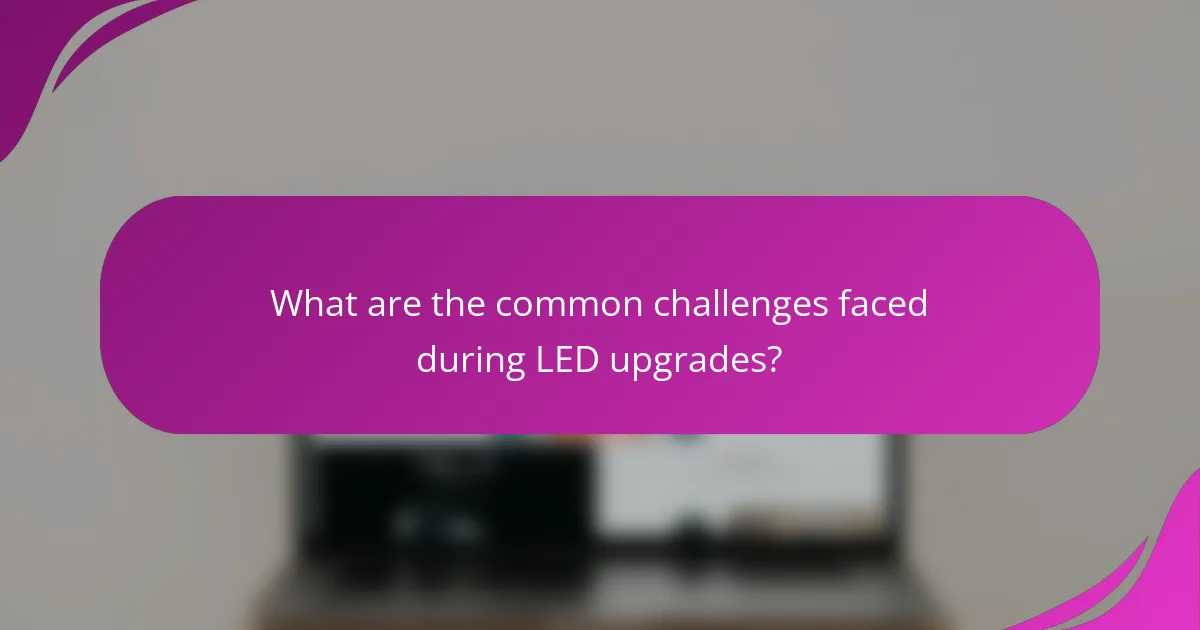
What are the common challenges faced during LED upgrades?
Common challenges during LED upgrades include initial investment costs and the need for staff training on new systems. Addressing these issues effectively can lead to smoother transitions and greater energy savings in retail environments.
Initial investment costs
The initial investment for LED upgrades can be significant, often ranging from several hundred to several thousand dollars, depending on the size of the retail space and the number of fixtures replaced. While the upfront costs may seem daunting, it’s essential to consider the long-term energy savings and reduced maintenance expenses that LEDs provide.
Retailers should evaluate available incentives, such as rebates or tax credits, which can offset these costs. Conducting a cost-benefit analysis can help determine the payback period, typically within a few years, making the investment more palatable.
Staff training for new systems
Implementing LED lighting often requires staff training to ensure proper usage and maintenance of the new systems. Employees may need to learn about the different controls and features of LED fixtures, which can vary significantly from traditional lighting.
To facilitate this transition, retailers should develop a training program that includes hands-on demonstrations and clear instructional materials. Regular refresher courses can also help maintain staff proficiency and ensure that the benefits of the LED upgrade are fully realized.
